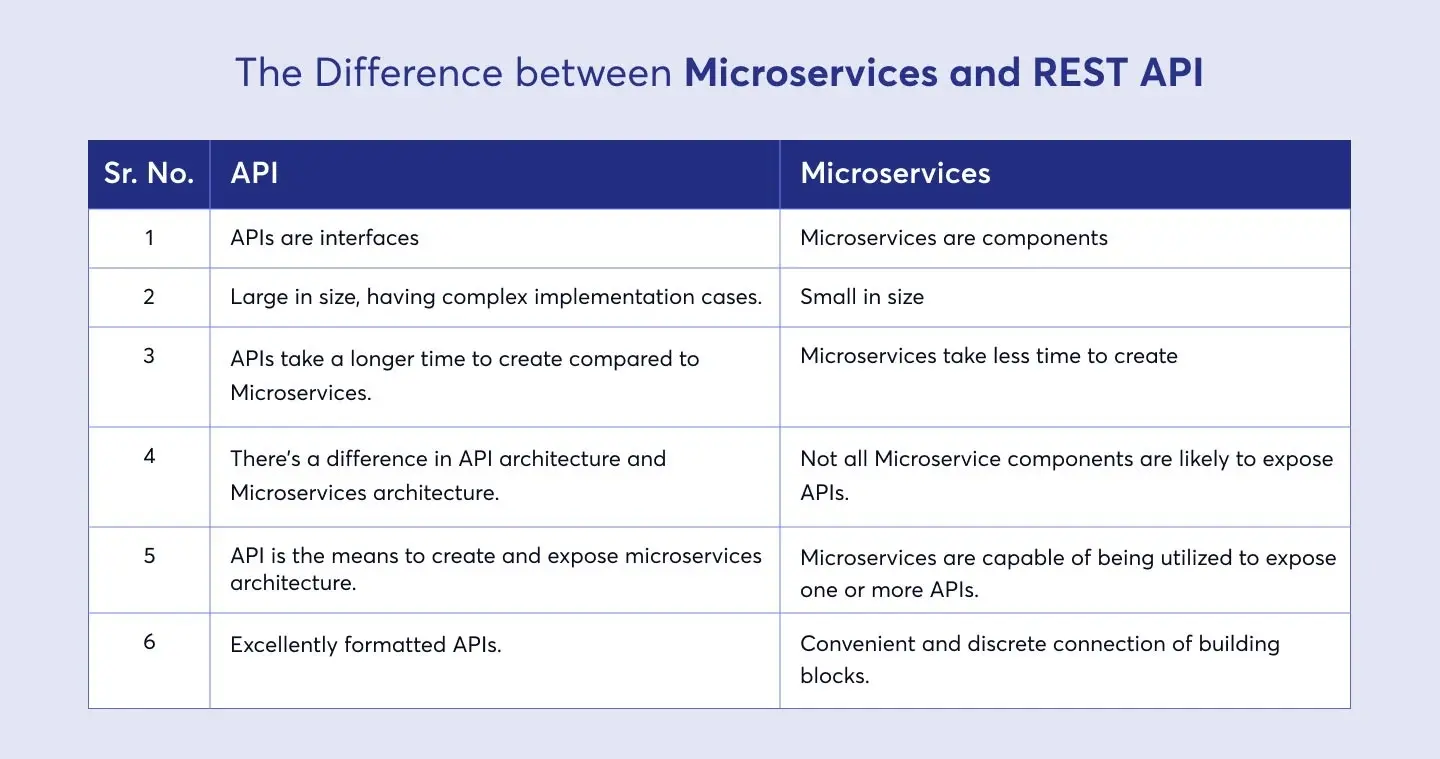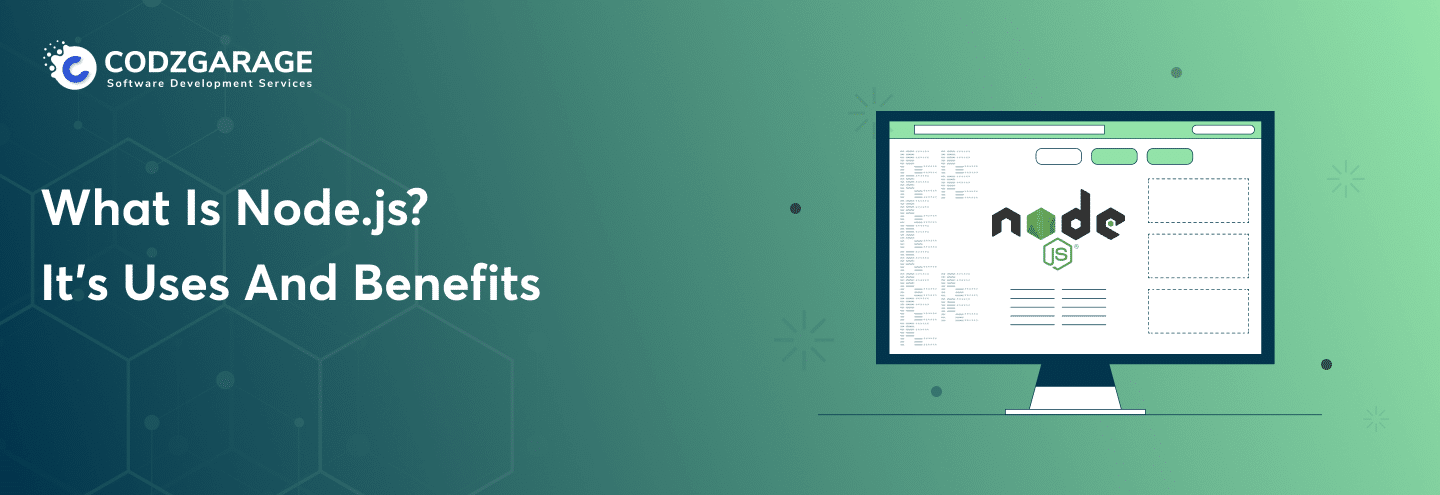-
1867
REST APIs vs. Microservices: Key Difference Between API and Microservices
Microservices are the individual functions and services or the building blocks to create a large microservices-based application while are the rules. But there’s a lot in-between. We will explore those gaps in this article.
Have you ever been in discussion about software architecture and integration? If yes, you may have heard the two terms REST APIs Vs. Microservices. Despite working hand in hand, these two are entirely different from one another when talking about the way they work. Let’s know the difference between API and Microservices!
When it comes to creating a microservices-based application, the RESTful APIs and Microservices work synchronously. Although the two of them work hand in hand, they’re entirely different. They refer to different things.
Microservices are the individual functions and services or the building blocks to create a large microservices-based application. RESTful APIs, on the other hand, are the rules, commands, protocols, and routines that amalgamate separate microservices to let them function as a single application.
Codzgarage is the leading mobile app developmentcompany offering reliable and cost-effective development services.Connect with usand get free cost estimation and consultation.
Through this article, you’ll have an in-depth analysis of APIs and microservices. It’ll contain;
- The difference between API and Microservices,
- What they are,
- What their functions are,
- Why they are essential when creating microservices-based apps
So, without consuming any additional lines, let’s get straight on to the point;
What is REST API/s?
A REST API, or a RESTful API, is an application programming interface that’s utilized by two computer systems to share information with security over the internet. The REST, here, stands for representational state transfer. There are business applications that need to communicate with other internal as well as different third-party applications to conduct multiple tasks.
For instance, when generating payslips, internal account systems in a company require to share data with their customer’s banking system intending to make invoicing and communication with an internal timesheet application automated. Because the RESTful APIs follow reliable, secure, and efficacious software communication standards, they assist the information exchanges in a safe and secure manner.
What is Microservices
Microservices, or Microservices architecture, is a set of services to design specific software systems to build applications making use of the collection of services. The idea for microservices is to separate the applications into pieces that are likely to work together. However, the architecture has grown in complexity; the microservices architecture still surpasses the monolithic architecture in terms of advantages.
Did you know around 37% of organizations who responded were said to use microservices in 2021.
Microservices architecture enables organizations to scale and update each service without interrupting other services in an application. Microservices create a scalable and distributed system that circumvents the bottlenecks caused by a central database to elevate a business’s capabilities. This requires planning and given much consideration before architecting or re-architecting software.
Difference Between REST API and Microservices
When it comes to the difference between API and Microservices, there are likely to be many. Microservices develop a single application making use of small, interconnected services competent in communicating via APIs. APIs, on the other hand, ensure seamless communication between a host and a requester. It provides products and services to make use of their data and functions via a documented interface.
While an application can consist of many microservices, each making use of an API to establish a connection with one another, APIs serve as an element that acts to conduct interaction among a variety of technology stacks. Look at the table below to gauge the difference between Microservices and REST API.

Pros & Cons of REST APIs and Microservices
Whether you are building a new application or migrating legacy systems to the cloud, knowing their dos and don’ts will help you become familiar with software development. After understanding the basics, like their kinds and differences, let’s compare REST APIs vs. Microservices based on their advantages and disadvantages. This comparison will let you understand how these two will be beneficial for your project and why you should opt to choose them.
Pros of REST APIs
Let’s take REST APIs first to examine in terms of performance and advantage!
- Speed— APIs provide an incredibly high-speed performance experience to both businesses as well as their users. They assist businesses in streamlining their workflow by offering agility in operations and lessening the hassle for customers. Take it for an example, when you want to order stuff from an online store, you can check the item for its availability directly and order them conveniently.
- Increased Productivity— Productivity comes with quality, smart solutions, and smooth processes. Making use of APIs allows developers to add more functionalities they need in a heartbeat with no need to create them from the get-go. This is what assists businesses as well as customers, saving a gargantuan amount of time and investing them in doing other necessary business activities.
- Promotes Innovation— The exponentially growing competition among businesses, regardless of industry vertical, has made innovation an essential ingredient. Furthermore, customers’ demands are changing day in and day out, and businesses are expected to meet them in a better way possible. By easing processes and saving time, APIs boost innovation.
- Smoothen Collaboration— Because of increased security risks, maintaining smooth and flawless communication and connectivity has become way more troublesome than ever before for companies. But, with APIs, it’s no longer the issue. Businesses using APIs can now smoothen communication and collaboration among team members for a better experience of connectivity.
- Improved Scalability— Are you a growing business? Then, you must make sure you employ a scalable tech stack that scales as your business grows. When you implement APIs, you open the door for welcoming tremendous opportunities to grow your business as time passes by. It allows you to extend your products, manage enhanced data, increase the number of catalogs, and competently handle security risks.
- Next-Level of Customer Experience— Do you want to give your customer’s a next-level of experience? Then choosing APIs would be the right way to go. APIs capacitate customers to get connected to businesses and air their grievances relating to challenges, interests, and preferences. When a business gets input, they work on them and try to better them, which, as a result, enhances the customer’s experience.
- Robust Security— Making use of APIs is a robust way to strengthen security. This is because when you make an API call, you don’t get connected directly to the web browser but send small-sized data to get delivered by the API to the server and get responses from there. It keeps your application from any attack.
- Mitigated IT Cost— It involves a significant amount of investment to build an application. For that, you need tools, technology, dexterous app developers, and many other resources to create an app that meets your goals. Here, you may get flabbergasted to know that you can now circumvent the need to afford these all by simply choosing an API for app development and enhancing its functionality with no need to spend a fortune.
Note: You should bear in mind that when you employ APIs, you can customize customers’ experiences, which can be a building block to your business success. For instance, you can opt to choose (AI) artificial intelligence-based APIs that’ll assist you in gauging your buyer’s journey. With this system, you can analyze a buyer’s journey right from when they visited the site to their completion of the purchase from there. The system backs you in mapping out the difficulties a customer encounters while making a purchase from your site to fix them with appropriate alternatives and make the process more convenient for them.
Cons of REST APIs
Similar to any other thing, the APIs undoubtedly have pros but have some challenges and drawbacks as well.
- Absolute Uses— The characteristics and other features of APIs are so good that companies would likely use them excessively. When several APIs run on your company’s services, endpoints, and dependencies, chances are, it would be difficult for an organization to handle them. They may find it hard to control the uses of APIs, monitor data and protect security.
- Excessive Reliance on APIs— Using APIs can be likely to get your application not being self-performant by relying on them absolutely. When the API comes across any issue, it will affect your app’s performance, too, even when your application doesn’t have any issues. It means if the API gets attacked by any wrongdoer, your app’s data, too, will get affected.
- Not All APIs are Secure— There’s no certainty that every API will be secure, and that’s the concern organizations get afraid of while choosing to use APIs. That’s the preliminary concern organizations face while using APIs. It may leave your app vulnerable to cyberattacks; therefore, you’re advised to choose API carefully.
Pros of Microservices Architecture
Separating the app’s functions into small parts, microservices, too, has numerous advantages in store to offer its users. Here are some of them, if we name a few!
- Separated Development— Streamlined development is one of the best advantages of microservices. With a microservices architecture, you can have a streamlined development procedure— as even a team of a few members can work on development, testing, deployment, and so on.
- Modularity— The term “Modularity” consists of the procedure of separating services into different modules with their own functionalities and dependencies to make it convenient to build an application, test it, and perform further execution. It lightens the difficulties and complexities organizations deal with while app creation using a monolithic software development approach.
- Streamlined Time to Market—Faster code creation, testing, debugging, and deployment with ample quality assurance, the Microservices architecture ensures users get a streamlined time to market. Besides, you’ll be able to receive feedback early and better your app faster rather than waiting for the entire system to be checked in one go.
- Independent Deployment— Since services are separate, they can get deployed independently. Whenever you make any change in an app, you won’t be interrupting the entire application. As when you need to improve an application, you take a microservice and start working on it to merely make that part better. When it gets done, you deploy it with no need to redeploy the whole application.
- Seamless Integration— Microservices are convenient to be integrated with different tools and technologies to assist you in better your app’s features and functionalities along with security.
- Scalability— Microservices architecture follows the implementation of a loosely coupled approach. It involves segregating the business logic, database, and data access layer. Moreover, microservices are likely to be created and launched independently and can be scaled conveniently.
- Better Flexibility— Flexibility is another good aspect of Microservices. With microservices, you can freely choose to utilize any technology stack, like a programming language, framework, library, and many other tools supported for various components and services. Thereby, you’ll be likely to create state-of-the-art services to make your application secure and feature-rich.
- Accelerated Productivity— When you implement a distributed development methodology wherein responsibilities are separated, it’s likely to assist you in boosting organizational productivity. In this approach, large tasks can be broken into many tiny ones that would be convenient to perform.
- Robust Security— Microservices architecture is built in a way that can cope with compromises and failures. A variety of services interact inside an application; a service may fail because of cyberattacks, server issues, and so on. With a microservices architecture, even when one of the services fails, it won’t affect the entire application—as the other elements will still continue to perform without getting interrupted.
- Convenient Maintenance and Debugging— Smaller services are more likely to be convenient in terms of maintenance and debugging. Developers can easily analyze the entire service and find errors and issues in no time.
Cons of Microservices Architecture
Microservices are, indeed, an efficient approach that’s able to offer you a multitude of benefits; this, too, has some drawbacks that you should take a look at.
- Complexity— Migrating from traditional architecture to microservices tends to be a complex procedure that involves many processes that need a team of experts to work on them for the development and deployment of the entire application.
- Compatibility Issues— New versions of the software would pose problems related to backward compatibility.
- Latency Issues— Many networks may cause more latency and connectivity-related inconvenience.
How REST APIs and Microservices Work Together?
Both APIs and microservices work together in an application. However, they exist separately; by using them together, an application will be able to assist companies in implementing the microservices architecture with ease. Many organizations may encounter hassle deploying microservices architecture when they already have an architecture launched.
Apart from that, the integration of several smaller and separate services and squeezing benefits from them wouldn’t be that easy. That’s why employing an integration strategy making use of APIs is of utmost significance to make the best of microservices architecture.
When using APIs, businesses will be able to leverage their full potential of it and achieve the next level of speed and flexibility. Microservices offers its users enhanced flexibility and incredibly accelerated speed while lessening the complexities associated with software development and deployment.
APIs Manage Microservices Effortlessly: Furthermore, APIs are capable of making it tremendously effortless to create and manage microservices, along with providing this innovative model to coexist with legacy systems with ease. In this way, an organization doesn’t need to discard all its legacy systems at once, and this is what circumvents them from tolerating stress caused by interruptions. Apart from that, you can expose microservices functions as products to enhance business value internally and externally.
Besides all these, APIs help you lessen the IT expenses for creating point-to-point integration between your legacy systems and SaaS applications. Following this way, you’ll be able to add or remove your microservices as per your needs quickly. The microservices also standardize traffic management, auditing, logging, monitoring, security, and many more. Therefore, combining microservices with APIs will let you achieve all the advantages of microservices by limiting their drawbacks.
Real-world Examples of Platform Leveraging REST APIs and Microservices Together
The familiarity, along with the reliability of RESTful API commands, protocols, and rules, makes it way easier to build applications with competencies to integrate with an application with an associated API. It becomes the case when companies, for instance, Twitter, Facebook, Instagram, and/or Salesforce, wish their services to be available to get integrated with third-party apps.
You can have an excellent example of RESTful APIs in action in the guise of the Facebook Messenger application. Messenger consists of a multitude of microservices, for instance, “Send” to send messages and “Attachment” to attach and send files. Facebook has published a multitude of RESTful APIs to let developers build third-party applications capable of integrating with these and additional messaging services.
Signing Off….!
That’s all there’s to it! That’s everything about the difference between API and microservice. We started from the very basics and left no aspect untouched from our intense analysis. First off, we learned RESTful APIs and Microservices architecture, then the difference between microservices and rest API, the pros and cons of both, and eventually, how APIs and microservices work synchronously.
We hope this article will serve you with the best possible; if you’re on the verge of building an application, get in touch with us– as we’re the best in class custom software development company creating groundbreaking solutions for businesses across the globe.
Want to
Hire Node.Js DevelopersOur Expertise
- Skills expertise
- 11+ Years of experience
- Committed to deadline






 Kevin Bhut
Kevin Bhut 







